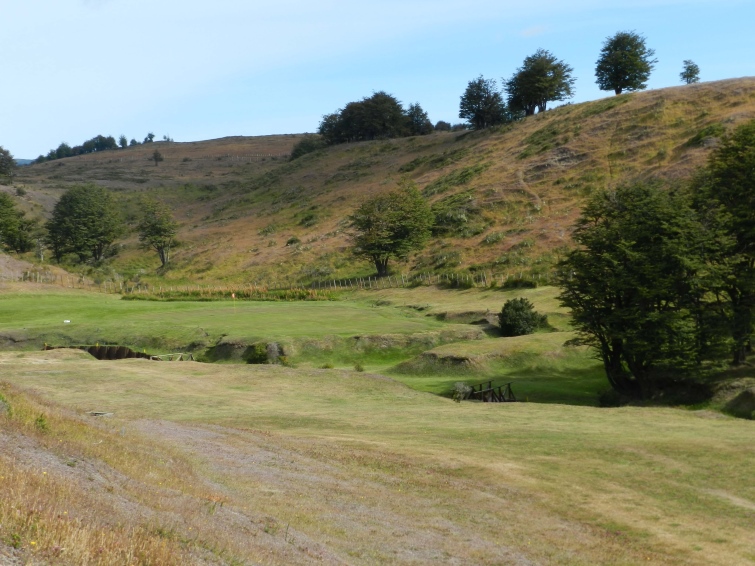Feature Interview No. 5 with Tom Doak
September, 2015
1. What was the most curious response to Volume 1?
The limited edition of the Guide back in 1994 generated hundreds of letters from readers; the new book has hardly generated any. I guess people know what to expect. The most curious response to me was the media’s focus on the one negative review in the book instead of the nearly 300 more positive ones. Media loves controversy, even when they have to squeeze hard to create some.
2. If condemned to confine one’s play to either all the courses in Volume 1 or all the courses in Volume 2, which would you select?
Volume 1. It’s possible the courses in Volume 3 will give those a run for their money, because there will be 500 courses vs. 300. But that wasn’t enough for Volume 2, even with California on its side.
3. What kind of pressure did that then apply to make Volume 2 as interesting a read as Volume 1?
No pressure, from my end. Volume 2 includes 502 courses in a lot of interesting places, and a lot of them have great character, whether or not as many vie for spots on the top 100 lists.
4. The landscape alters quickly across the United Kingdom. Conversely, there about ~one million courses in Arizona for instance and at some point, describing residential courses with island fairways becomes repetitive. How did you handle that?
With only a few lines to sum up each course, I try to focus on what makes them different from one another. As I wrote in the introduction to the Southwestern courses, the drainage patterns of the desert tend to drive the designs there toward a similar look and feel; but some courses are on better land than others, some have better featuring, and some handle the transition to the desert better. If a course failed in all three of those areas, its write-up is pretty short.
5. Your 16 day tour of South America lends Volume 2 real spice. List chasers might be put off by the distance between courses but you seemed to quite enjoy yourself. Give us the highlights.
It was a crazy schedule … the architect Randy Thompson (who lives in Chile) set it all up for us, and as he said at some point, it was “the hardest routing [he’s] ever done.” 🙂 We went back and forth from Santiago to La Serena to the Straits of Magellan, to the Lake District, then across the Andes pass to San Martin and Bariloche in Argentina, and from there to Buenos Aires and Mar del Plata and Cordoba. My friend David Lee tagged along for most of the trip, too, although neither he nor Randy came with me for my final stopover to see La Paz Golf Club, in Bolivia. [Their loss!] There’s a bit of a Wild West feel to the whole country.
Most every course we saw had something to recommend it. The golf culture in Argentina was very strong at clubs like San Andres and The Jockey Club and Mar del Plata, and even the small La Cumbre course in the highlands outside Cordoba; and I thought the new courses up in the mountains were especially good. Chile was much more laid-back — it reminded me of California in terms of climate and attitude — but there are only 8000 golfers in the entire country, so our dream of building a great course along the rocky coastline within reasonable distance of Santiago would take a client with very long-term vision. We did fly nearly 2000 miles from Santiago to Punta Arenas to see an 11-hole course with one hole that made the trip worthwhile!

The 400 yard eleventh hole at Magallanes Golf Club requires a carefully considered approach across a stream that cuts diagonally in front of the green.
6. Since the publication of the initial The Confidential Guide, which geographic region covered in Volume 2 has progressed the most?
Florida has seen some dramatic improvements in the past twenty years; so have Texas and the Caribbean. But probably the biggest jump is that of Mexico. When The World Atlas of Golf was published in 1975, Club de Golf Mexico [which, sadly, none of us had a chance to see] was the only Mexican course worth mentioning … today there are all the courses around Cabo San Lucas and Puerto Vallarta, and scattered all around the country. Jack Nicklaus alone has built 24 courses in Mexico! … and many of them with his pick of property. It’s the only region we didn’t do a very good job of covering, because so many of the noteworthy courses were built in the past 15 years.
7. Which region still falls well short of its potential?
It depends on how you define potential. South America has thousands of miles of undeveloped coastline, including one or two stretches that had me drooling on my trip this spring — but the potential to create something that sustains itself economically just isn’t there right now. Hawaii seems like it should be an easy place to build a great course, and there is plenty of money on hand; but the money has driven up the land values so much that nobody will consider putting much golf on the most attractive parcels. [Archaeology conflicts are also an issue there.] So I guess I’d have to say that the Deep South [from Georgia across to Arkansas and Louisiana] is the laggard for great golf. I did find a few neat courses in my two whirlwind trips this past winter, but most of the new projects that have been built were about housing first and golf, second.
8. Relative to the other volumes, would you agree that the courses in Volume 2 are the greatest beneficiaries of agronomic advances made in the past 20 years?
Surely. The development of paspalum that can thrive on desalinated water has paved the way for all those new courses in Mexico and the Caribbean. And the development of ultradwarf bermudagrasses like Champion and MiniVerde have allowed courses across the region to provide superior warm-season putting surfaces, replacing the soggy bentgrass greens that never had any business being planted so far south.
9. Readers might be surprised to find some Doak 7s scattered among some of the newly built courses in the Caribbean. Are developers finally preserving some of the best land for golf there?
I was surprised myself at the quality of new courses like Baha Mar in The Bahamas, and Punta Espada and Corales in the Dominican Republic. The latter two have a lot of choice ocean frontage reserved for golf. Baha Mar is actually a redesign of an older course; it never touches the shoreline but it does incorporate some new, rocky land leading over to a large inland lake for its island-green 16th hole.
10. Which is your favorite island course – Teeth of the Dog or Mid Ocean?
There’s a loaded question! I have been consulting at Mid Ocean for nearly twenty years now and I’m pleased at how much better it plays today, mostly thanks to the conversion of the greens to ultra-dwarf Bermuda. It’s one of the most relaxing places I know, and it’s pretty cool to go for a dip in the ocean down below the 18th green every evening after work. By contrast, I haven’t been back to Teeth of the Dog since I started going to Mid Ocean, but I was there three times when I worked for Mr. Dye and I cannot take lightly how proud he was of that course. He never minced words that it was the best course he’d ever done, though I guess Mr. Kohler has him hedging those words nowadays.
11. If not for the publication of Volume 2, would you have ever made your way to Laurel Country Club in Mississippi?
I might have, because the recommendation to see it came from the late John “Tiger” Bernhardt, who I met through Golf Club Atlas fifteen years ago. John was an old-school golf guy, and when I asked three years ago about what courses in Mississippi I might try to see, he wrote, “[Laurel CC] uses land feature as well as Seminole works magic on one sand ridge.”
Then again, I almost didn’t see it this time. I was driving from New Orleans across to the Florida panhandle on a beautiful afternoon, perfect for photos, and I was going to stop in to see Tom Fazio’s Fallen Oak course, but they wouldn’t let me in the gate without a reservation! I was so ticked off that I decided to drive up to Laurel instead of calling it a day. I had to power-walk the course in about an hour before it got dark; if I’d had more time, it might have been one of the courses in the front of the book.
But, would I have ever taken up John’s recommendation if I hadn’t started this book project? I might not have, and that’s the main reason I revived The Confidential Guide. It’s easy once you find success as an architect to keep doing the same thing over again; to avoid that trap, I need outside inspiration. Finding courses like Laurel is what keeps me going. Hopefully, my review of the course will send a few more guests their way.
12. What else did preparing Volume 2 force you to do that you might not have done otherwise?
Well, we couldn’t let any state go without representation in the book, and none of my co-authors shot up their hands to fill in our gaps in Louisiana, Mississippi, and Arkansas. I probably wouldn’t have gone to The Bahamas, either, and that turned out to be one of my wife’s favorite vacations ever. And I certainly wouldn’t have gone through all the hassle to get a visa to Bolivia so I could see La Paz Golf Club — I had to get three shots and submit a police background check! What a cool place; it’s too bad they make it so hard for Americans to get there.
13. Did you strike out on a trip that proved ultimately disappointing?
The weather for my swing through Arkansas and Oklahoma this spring was brutal — flooding, tornado warnings, lightning, etc. I saw some good courses, but I could only play twice. I guess I was hoping to find an undiscovered Perry Maxwell gem, but I didn’t quite find it — though Hillcrest CC in Bartlesville, OK was a lovely small-town club.
14. What three green complexes most impressed you that you saw for the first time in compiling Volume 2? How about three hazards?
That is a tough question, because I’ve been working on Volume 3, and just last week I saw some doozies at Bald Peak Club and Granliden in New Hampshire! I’ll try to re-focus:
Seeing a picture of the 11th green at Magallanes GC, in southern Chile, is what prompted me to make Randy and David fly further south than any of us had ever traveled before … and it was worth the trip. The seventeenth green at Streamsong (Red) isn’t entirely a result of the book, I got to watch Jimbo Wright create it for Bill Coore while we were working next door, but it’s a great representative for a pair of courses that have a ton of cool green complexes between them. And the sharp tilt of the 3rd green at Wolf Point, offset behind flanking bunkers on the right, illustrates what makes that course so special.
For hazards, I’ll start with the overhanging oak trees at Capital City CC in Tallahassee. I’d never heard of the course until I happened to play with one of their members at Lyford Cay. I’ve got to include some bunkering by Mike Strantz; I’ll go with the green side bunker on the 15th at Bulls Bay, which sees a lot of action because of an oak tree guarding the approach. And how about the snaking stream on the 11th and 12th holes at Oklahoma City G & CC? I’ve never seen a stream that comes into play on both sides of a hole quite like that one.
15. What was some of the best restoration work that you came across? What one course most sorely could benefit from a proper restoration?
I’m sure it would be Old Town Club, if I’d been back; I had to rely on you for a first-hand report there. The work at Los Angeles Country Club (North) is exceptional, especially in re-creating some of George Thomas’ alternate teeing grounds. Pasatiempo and The Valley Club have also come a long way from when I first saw them 30 years ago.
There are two courses in this region that I’d love to restore. The first is Dornick Hills, Perry Maxwell’s first design, in his hometown of Ardmore, Oklahoma. The greens were neutered in the 1980’s [just before I saw it for the first time], and I don’t know if there is really any good documentation on how to put them back, but I would happily move there for a summer and give it my best shot. The other is Bel Air in California, but they seem to still be moving in the other direction.
16. Volume 1 is littered with courses of all shapes and sizes. The same potential for describing such did not exist for Volume 2 yet, you found one in both Louisiana and Argentina. Tell us about them.
The first course in The Gourmet’s Choice this time around is the municipal Audubon Park GC in New Orleans, which was redesigned a few years ago by Denis Griffiths. Architects talk constantly about “thinking outside the box,” but few would have the courage to look at a tight muni and suggest a par-62 course with twelve short holes, four par-4’s, and a par-5 to conclude each nine. It’s terrific work, and the locals take great pride in it.
The funny thing about Argentina is that I wasn’t sure whether you were asking about El Potrerillo de Larreta, or Ellerstina … and you were asking about Mar del Plata! Everyone in Argentina who considers themselves a true golfer holds a non-resident membership at Mar del Plata. It sits on a bluff overlooking the Naval College and the Atlantic, with public streets tight against the boundaries on three sides of the property; when I was there they’d just had to put up obnoxious fences on four holes because of an errant-ball lawsuit, because the fairways are right along the boundary, and with only ninety acres of golf course there isn’t any room to move the holes further to the center of the property. But it’s a terrific course that plays as bouncy as any links, and the par-3’s hanging off the edge of the bluff are great holes.
17. Traveling for Volume 3 is almost complete. Give us a sneak peek at three Gourmet Choices that you will be profiling for the first time.
We have not yet finalized the Gourmet’s Choice for Volume 3; it’s an awfully competitive list of courses vying for the honor. I’m going to leave the choice between Jasper and Banff for Masa to decide; I played both in June and would be happy to write about either, but I know Banff is one of his all time favorites. Another co-author has suggested Fowler’s Mill in Ohio, by Pete Dye; I have to admit I knew absolutely nothing about it. Whichever Donald Ross course makes it will not be well-known to most readers, but whether it will be Essex County or Roaring Gap or Glens Falls or somewhere else, I still haven’t decided. But just last week I did decide on a new entry: the nine-hole Hooper Golf Club in New Hampshire, by Wayne Stiles.
18. Where do you have your eyes set for trips for Volume 4?
I am hoping that I can convince my wife to live in Europe for part of 2016 so I can see a bunch of courses there without being away from her for so long … if it takes two years then so be it. Masa and Darius have covered a tremendous number of courses on the Continent, but I really haven’t played much at all on the Continent outside of France and The Netherlands; so I have the luxury of going where I want, and falling back on their experience for the rest. From a golf standpoint, the two countries that interest me most are Portugal, and Morocco [where none of us have been yet]. From a personal standpoint, I’m looking forward to visiting Scandinavia and parts of Eastern Europe, and getting back to South Africa. But the most far-out destinations on my list are Greenland and Israel. There is only one course in each country [actually Greenland isn’t even a country, it’s a territory of Denmark], but both places fascinate me for very different reasons, and including them in the book is a great impetus to visit.
The End






